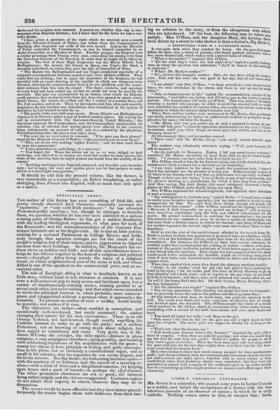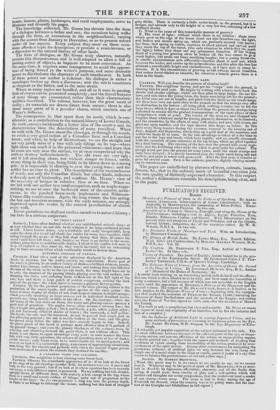GOSSE S CANADIAN NATURALIST.
MR. Goss's: is a naturalist, who pissed some years in Lower Canada as a settler, and varied the occupations of a farmer with the less laborious pursuits of an observer of nature ; in which he is truly catholic. Nothing comes amiss to him, or escapes him; birds,
beasts, insects, plants, landscapes, and rural employments, serve to illustrate and diversify his pages.
The knowledge collected, Mr. GOSSE has thrown into the form
of a dialogue between a father and son; the occasions being walks through the farm, or excursions in the neighbourhood ; varying with the season from January to December, so as to present nature under all her aspects. Every subject they meet on these occa- sions affords a topic for description, or permits a reminiscence, or a digression to the natural history of other lands.
The form of dialogue, as Mr. GOSSE truly observes, naturally permits this discursiveness, and is well adapted to allow a full or passing notice of objects, as happens to be most convenient. At the same time, it requires some management to avoid the appear- ance of being forced to the writer's purpose, and some dramatic power to discriminate the character of each interlocutor. In both of those points our author is deficient : his dialogue is rather a monologue broken up than a discourse; and the son is sometimes as eloquent as the father, and in the same strain. Where so many topics are handled, and all as it were in passing, little of course can be presented completely ; and the literal features of many things arc enumerated, rather than their characteristic qualities described. The volume, however, has the great merit of reality ; its materials are drawn direct from nature ; there is also about many parts of it a peculiar charm, which reminds one of Mures Selborne.
The consequence is, that apart from its merit, which is con- siderable, as a contribution to the natural history of Lower Canada, the work conveys incidentally a better idea of the country and its characteristics than the descriptions of many travellers. When we walk with Mr. GOSSE about the clearings, or through the woods, we catch a very good notion of a Canadian farm and a Canadian forest ; and when, by help of illustrations, we see the straight and not very gainly stem of a tree with only foliage on its top—where light alone can reach it in the primmval wilderness—and learn that its roots arc very near the surface, we at once comprehend why the settlers destroy indiscriminately. The old trees are very ugly ; and if left standing alone, not without danger to fences, cattle, or any thing in their way, being liable to be blown down in a strong gale : it is impossible in clearing to save the young trees ; and the settler has no time to plant. The description of the encroachment of weeds, not only the Canadian thistle but other kinds, indicates a slovenly sort of husbandry, and confirms Mr. Munu.s view of the necessity of hedges in colonies, tune or no time. When we are led with our author to a rural occupation, such as maple-sugar- making, we see at once the backward state of the country settle- ments, in the patched home-made implements arid Robinson- Crusoc-like contrivances. Again, the long winter, the late spring, the hot and transient summer' with the early autumn, arc strongly impressed upon the reader by the natural peculiarities of almost
every walk.
In our quotations we shall not confine: ourselves to natural history ; but here is a curious conjecture.
DO msnes SLEEP?
Seriously, I have often doubted whether any cold-blooded animals sleep; or at least whether they are not able to do without it for long-continued periods at will. I have known fishes, very remarkable and easily recognizable, keep under the stern of a vessel and about her rudder for many days together, while sailing through the ocean : if they had slept during that time, of course the
i
vessel e mild have left them ; and, besides, as there s no shelter in the ocean, without going down to unfathomable depths, I think if the smaller fish were to sleep, all exposed as they must be, they would inevitably tall an unresistin,g prey to those ravenous tribes which continually watch to devour them.
AUTUMNAL FOLIAGE OF CANADA.
CHARLES. I Ilna often read of' the splendour displayed by the American forests in autumn, but the reality exceeds my expectation. Every part of the woods is glowing in an endless variety of shades,—brilliant crimson, purple, scarlet, lake, orange, yellow, brown, and green ; and looking from this hill over the tops of the trees, as thr as the eye can reach, the same bright hues are to be seen; the shadows of the passing clouds, playing over the vast surface, now dimming the tints, now suffering them to dash out in the full light of the sun; here and there a lame patch of sombre evergreens, making the dark parts of the picture: the whole forest is become a gigantic flower-garden. FATHER. By far the greatest proportion of the more glowing colours is the production of the sugar-maple, and other species of the same genus: the leaves of these display all shades of red, from deepest crimson to bright orange; which generally occurring in large masses, not in individual detached leaves, prevents any thing tawdry or little in the elf, et. On the contrary, when the full beams of the sun shine on them, the warm and glowing colours possess a great deal of grandeur. The poplar leaves often assume a crimson hue; the elm, a briLfht and golden yellow ; birch and beech, a pale, sober, yellow ochre ; ash and basswood, different shades of brown ; the tamarack, a huff yellow. The bevel], the ash, and the tamarack, do not in general bear much part in this glittering pageant ; the ash is mostly leafless at the time, and the glory has passed away befiwe the other two have scarcely begun to fade. Indeed, the glossy green of the beech is perhaps more effective than it' it partook of the general change ; and even the gloomy blackness of the resinous trees, by relieving and throwing forward the gayer tints, is not without effect. This beauty is not shown to equal advantage every year ; in some seasons the trees fade with very little splendour, the colours all partaking more or less of dusky, sordid brown ; early frosts seem to he unfavourable (hr its development ; and even at its best it is a melancholy glory, a precursor of approaching dissolution, something like the ribands and garlands with which the ancient Pagan priests were accustomed to adorn the animals they destined the sacrifice.
A CANADIAN WOOD AND CLEARING.
Crunr.cs. Our neighbour is here clearing smile forest-land.
FarnEll. Observe the remarkable appearance of it : if we look at the forest at the edge of an old clearing—yonder held, for instance—we see it green and leafy to the very ground ; but it' we look at it where a portion has been recently cut away, a very different aspect is presented. We see nothing but tall, slender, upright stems of different sizes, with scarcely a leaf, except at the top, where there is a small and scanty surface of foliage, quite out of proportion to the height of the trees : the eye Can penetrate a long way into the gloomy depth, as there is no foliage to intercept the vision ; nothing but this host of straight gray sticks. There is certainly a little under-brush mt this ground, but it is meagre, and extends only to the height of a very few fept, consisting of a few scattered shrubs.
C. What is the cause of this remarkable manner of growfs ? F. The want of light; without which there is no foliatiut : those trees which grow on the edge of the forest shoot out side-branches hto the light, and bushes and shrubs spring up, which are profusely covered vith leaves; but those that spring up within, continue to shoot upward and nye-kid until they reach the top of the forest, (the only situation in which they ca reach the light,) before they shoot out any permanent branches, if the le.ling shoot of a young tree growing alone be broken off, the tree ceases to gem much higher, but sends out many ramifying boughs; but a young forest-trek in similar circumstances acts differently—another shoot is sent out, which becomes the leader, and carries up the perpendicular, and this after the tree has attained a considerable height and circumference, as I have seen in many in- stances. It is this circumstance of growing so tall without lateral branches, that makes forest-timber so valuable, for wherever a branch grows there is a knot in the trunk.
CLEARING LAND.
CHARLES. Will you describe the process of clearing land? FATHER. Our neighbour having just got his "crops" into the ground, is clearing this for next year. He begins by cutting with a heavy bush-hook the shrubs and slender saplings, which are then piled in large heaps: the axe fol- lows, and cuts down the young trees, the larger ones being left for the present; the felled ones are cut in lengths, and piled with the limbs on the brush-heaps. All these have been cut quite close to the ground, so that the stumps may offer no obstruction to the harrow : all being piled, nothing remains but to fell the large trees; which is done at about two teet from the ground, the stumps being permitted to remain till the gradual decomposition of the roots allows of their extraction—a work of years. The trunks of the trees are now chopped into lengths; those which are useful for fencing placed by themselves, to be removed; and the remainder, by the efforts of oxen with chains and men with levers, are piled one upon another, and the tops thrown into heaps as before. In this state every thing remains during the summer, exposed to the burning sun of July, August, and September, which dries up a good deal of the moisture, and makes the heaps fit to burn. In the fall, advantage is taken of a dry time to put fire to the logs and brush, which burn rapidly, and are usually consumed, with the exception of some remnants of the log-heaps, which are piled together for a final burning. The running of the fires over the ground kills every vege- table, and the fertilizing ashes make the whole in good order for culture. The plough is not put into the ground for some years, until the small stumps and roots have decayed : it is merely harrowed over, the virgin earth being soft and mellow; and grain is sowed with grass-seed. After the first crop, it remains in grass for several years. Such is the ordinary practice, slightly varying accord- ing to circumstances.
The pages are embellished by pictures of trees, animals, insects, flowers, tke., that to the ordinary merit of beautiful execution join the rare quality of distinctly-expressed character. In this respect the author's delineations resemble his descriptions, being clear, and to the point.



























 Previous page
Previous page